

You could run Netflix on your smartphone and tell it to run on a Windows 10 AIO or a huge screen with an Intel Compute Stick hanging out the back. Microsoft have also created a casting API that can be used by developers to enable their Universal Apps with casting features and the good news here is that if, for example, Netflix were to create a Windows 10 app with DIAL send and receive support it would work between all Windows 10 devices on the same network. Remember that DLNA is a media ‘director’, Miracast is a screen/audio streaming service and DIAL is a remote application control protocol that works in a similar way to Chromecast. Windows 10 supports ‘Cast to’ natively with the File Explorer and will search for Miracast, DLNA and DIAL-capable targets. ‘Cast to’ is replaces ‘Play to’ and the charm-bar method used to send via Miracast and WiDi.

The good news is that Microsoft have done work to make it easier to cast. It’s good news and bad news at the moment.

I’ve done a few tests on Miracast with Windows 10 and the results look better than before but today I took the time to drill down into DIAL and DLNA.


 0 kommentar(er)
0 kommentar(er)
